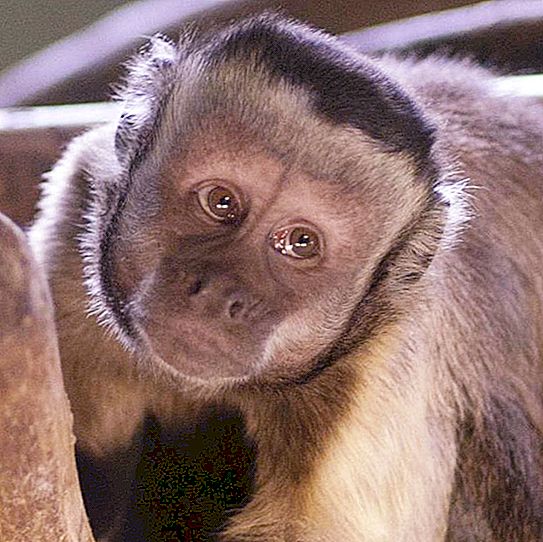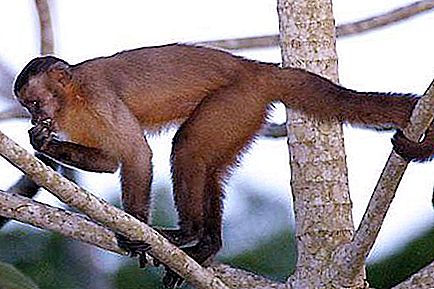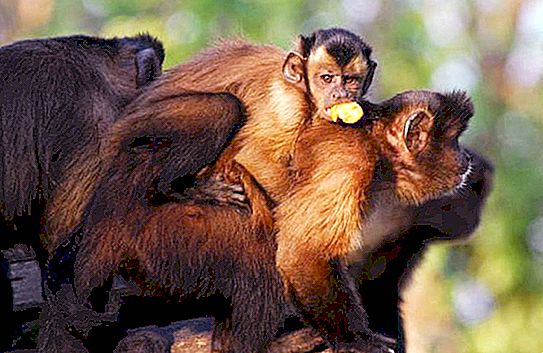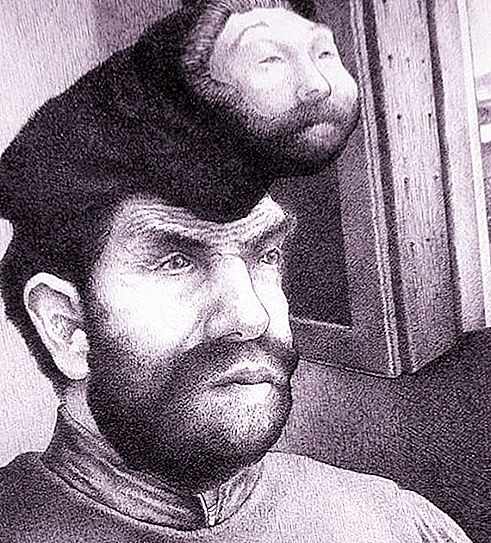Brown capuchin - the name is familiar to all lovers of the animal world. Who does not know these cute monkeys! They can be distinguished from other varieties of capuchins by two horn-like crests that are located on the head of an adult animal. These primates are one of the largest representatives of the chain-tailed monkey family.

Brown capuchin, apella, black-headed capuchin, faun - these are all the names of one species of animal. An interesting fact is that the brain of these creatures makes up about 1.9% of the total weight. In humans, this figure is about 2%, and in chimpanzees - only 0.9%. Based on this, it can be argued that the Capuchins are the most intellectually developed monkeys in the world and can compete with large primates with their ability to learn and solve complex problems.
Brown capuchins: habitat
Black-headed monkeys prefer to live in tropical and subtropical forests, but they can also be found in gallery and dry forests. These mobile primates live even in mountainous areas at an altitude of 200-1100 m in the north-west of Argentina.
Nowadays, brown capuchin species are registered in such countries: Bolivia, Colombia, French Guiana, Paraguay, Suriname, Argentina, Brazil, Ecuador, Guyana, Peru, Venezuela.
Description of Brown Capuchins
The weight of an adult faun is 1.5-5 kg., But there are individuals that reach 6-7 kg. The length of the body is 30-35 cm, the tail is 30-55 cm. Apella is the only type of capuchin that can fold its long grasping tail into a ring. Males are much larger than females.

Black long straight hair grows on the faun’s head above the ears, forming two characteristic crests, because of this “headgear” this species of monkey is often called crested capuchin. One black stripe is noticeable on both sides of the head, this visually gives the muzzle a square shape. The face of the monkey stands out in a light red tint. The body of a handsome black-headed man is covered with wool, which is painted in dark colors: from dark brown and mustard yellow to black. On the shoulders of the "coat" is noticeably lighter. The tail, hands and feet are brown or black.
Wildlife Lifestyle
Brown capuchins live in groups of 10 to 30 monkeys. In such a community, males and females are usually equally divided, sometimes there are more “girls” than “boys”. The fauns communicate with each other with the help of sounds whose repertoire is very extensive: growls, screams, trills, whistles, twitter, loud croaking, purring and even grinding teeth.
Brown capuchins get along well with their neighbors, due to such peacefulness, different groups can feed quietly in the border areas of occupied territories. One community of fauns occupies 30-40 hectares, but it happens that one "state" of Capuchins lives up to 350 hectares, moving every day to a new place. The male, who plays the role of leader in the group, must ensure that outsiders do not invade the occupied territory. To scare away uninvited guests, the head of the family emits loud menacing cries. Thus, he announces that this is his kingdom, and entry into it is prohibited.
Brown capuchins: breeding
Faunas lead a polygamous lifestyle, the female herself decides which male to mate with. Capuchins do not have a specific time for the mating season. Most often, cubs are born in the drought season and at the very beginning of the rainy season. So weddings black-headed primates celebrate their weddings from April to July. The female gives birth to a baby every two years.
When the female begins to rush, she begins to pursue the male dominant in the group, uttering invocation cries and seducing him with her poses. A potential "bridegroom", noticing the courtship, the "bride" begins to repeat her gestures and at the same time sing, giving high notes. Mating occurs only once a day, after which the male for two days does not allow other applicants for her love to the female. Thanks to his efforts, she gives birth to a baby, conceived from the strongest male in the family, because during the time that the female spends under the protection of the leader, she passes the state of estrus.
Capuchin offspring
Capuchin pregnancy lasts 160-180 days. The capuchin cub, just born, is all covered with wool. He is completely helpless during the first month of life, then the grown monkey moves to the back of the parent. At the age of two months, a young capuchin begins to independently explore the world around him, but he is far from moving away from his mother. When a young faun turns 3 months old, he becomes more independent, so to speak, because throughout the whole year a female feeds a small child with her milk, helps to get solid food and protects from enemies as far as possible.

Females raise their offspring all together, helping each other take care of the babies. Males do not take any part in this. The period of childhood and youth of the Capuchins lasts a long time, during which time young people manage to learn everything that they need in order to survive in the wild.




